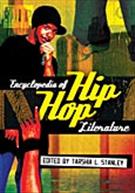– by RaShell R. Smith-Spears
Eisa Nefertari Ulen’s first Hip Hop inspired novel
It is the story of Crystelle Brown, a young Black professional from West Philly who seems to have a bright future. However, that future is threatened because Crystelle has yet to move beyond mourning the death of her high school sweetheart, Jimmie Johnson, whom she watched die before either of them even graduated from high school. In going back to her old neighborhood, Crystelle is faced with the ghosts of her past, both literal and figurative, and the challenge of deciding how she is going to live the rest of her life.
Ulen’s novel is a significant cultural work because it presents in its themes of death and life, remembrance, and rhythm, issues contemporary to hip hop audiences while simultaneously connecting those same issues to a historical yet timeless African American past. The theme of death and life is perhaps the most prevalent in the book. At one point, Crystelle’s grandfather tells her that she is walking heavy. He is unknowingly referring to the weight of Crystelle’s grief, the grief she feels at the death of Jimmie. She is also carrying Jimmie’s spirit as she is unable to let him go. Death enslaves her because she will not forget.
While Crystelle is unable to forget Jimmie, she is also called upon to remember her childhood in West Philly and realize the impact that it has had on her person. In a similar manner, the readers are asked to remember the lives and traditions of early African Americans as they struggled for survival in the United States. For both Crystelle and the Black race, these acts of remembrance are key to maintaining balance in an unsteady world that can strip you of your love, your life and your freedom.
Remembrance is also necessary to help maintain the rhythm of life. Ulen is most creative in illustrating that life is about its rhythm. There is a rhythm in the way Black people live and love, a rhythm in Black men’s swagger; there is even a rhythm in the way young Crystelle’s beads move when she wears braids. Crystelle’s grandfather tells her boyfriend, “Ain’t nothing’ new, man. The old sounds just layer the new.” This wisdom points to the evolution of hip hop music from jazz and blues rhythms. Moreover, it points to the steady beat of history’s march into the present. Crystelle’s childhood experiences are highly influential in the way she lives her life as a grown woman. Similarly, the manner in which African Americans live their present lives is due in large part to the experiences, good and bad, that they had during the past of enslavement.
While Ulen calls for audiences to remember the past and recognize the rhythms of life, she is also calling for forward movement. Crystelle should not forget Jimmie, but she — along with the Black race”will only be able to stop mourning and move toward the future if she is able to release the past.
~ RaShell R. Smith-Spears

Encyclopedia of Hip Hop Literature
by Tarshia L. Stanley (Editor)
This encyclopedia defines the world of Hip Hop literature for students and general readers. Included are more than 180 alphabetically entries on authors, genres, and works, as well as on the musical artists, fashion designers, directors, and other figures who make up the context of Hip Hop literature.